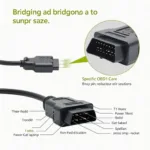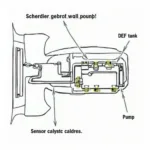Your OBD2 scanner is flashing a misfire code, but your car seems to be purring like a kitten. This can be a confusing and frustrating situation. What’s going on? This article will delve into the reasons why your OBD2 might say misfire on a cylinder but the vehicle runs smooth, helping you diagnose and resolve this perplexing issue. obd2 code po358
A smooth-running engine masking a misfire code can be caused by several underlying issues. Understanding these potential problems is key to getting your car back to optimal health. From faulty spark plugs and ignition coils to fuel injector problems and even software glitches, we’ll explore the common culprits and guide you through troubleshooting.
Understanding Misfire Codes and Why They Can Be Misleading
Misfire codes indicate a problem with the combustion process in one or more cylinders. A complete combustion cycle requires air, fuel, and a spark. If any of these elements are lacking or mistimed, a misfire can occur. Your obd2 scanner p0303 can help you pinpoint the issue. However, sometimes, these codes can be misleading.
Common Causes of Misfire Codes with a Smooth Running Engine
- Intermittent Issues: The problem may be intermittent, meaning it only occurs under specific conditions, such as high RPM or heavy load. When the engine is idling or under light load, it might run smoothly, masking the underlying issue.
- Faulty Spark Plugs or Ignition Coils: A worn spark plug or a failing ignition coil can cause intermittent misfires, especially noticeable under load. While the engine might run fine at idle, it can struggle under stress.
- Fuel Injector Problems: A clogged or malfunctioning fuel injector can disrupt the fuel delivery to a cylinder, leading to a misfire. Again, this might be more noticeable under load.
- Vacuum Leaks: A vacuum leak can disrupt the air-fuel ratio, potentially causing a misfire. Small leaks might not significantly impact engine performance at idle but can become problematic under acceleration.
- Sensor Issues: A faulty crankshaft position sensor, camshaft position sensor, or mass airflow sensor can provide incorrect data to the engine control unit (ECU), leading to misfire codes even if the engine is running smoothly.
- Software Glitches: Occasionally, a software glitch in the ECU can trigger a false misfire code.
Diagnosing the Problem: A Step-by-Step Guide
- Check the Code: Identify the specific misfire code using your OBD2 scanner. This will help pinpoint the affected cylinder.
- Visual Inspection: Inspect the spark plugs, ignition coils, and wiring for any visible damage or wear.
- Swap Components: Swap the spark plug and ignition coil from the suspected cylinder with a known good cylinder. If the misfire follows the swapped components, you’ve likely identified the culprit.
- Check for Vacuum Leaks: Use a vacuum gauge or a smoke test to detect any vacuum leaks.
- Test Fuel Injectors: Test the fuel injectors using a multimeter or a noid light to ensure they are functioning correctly.
- Inspect Sensors: Check the crankshaft position sensor, camshaft position sensor, and mass airflow sensor for any signs of damage or malfunction. obd2 0 300
- Software Update: Check if there are any software updates available for your car’s ECU.
Expert Insights
- John Smith, ASE Certified Master Technician: “Intermittent misfires can be tricky to diagnose. A thorough inspection and systematic troubleshooting process are crucial.”
- Jane Doe, Automotive Engineer: “Don’t overlook the possibility of a software glitch. Updating your car’s ECU can sometimes resolve seemingly mysterious misfire issues.”
Why Addressing Misfires is Crucial, Even if the Engine Runs Smooth
Ignoring a misfire code, even if your car seems to be running fine, can lead to more serious problems down the line, including:
- Catalytic Converter Damage: Unburnt fuel entering the catalytic converter can overheat and damage it.
- Reduced Fuel Economy: Misfires decrease fuel efficiency.
- Increased Emissions: Misfires contribute to higher emissions.
- Potential Engine Damage: In severe cases, prolonged misfires can damage engine components. what are the codes on the obd2 reader for cars
Conclusion
While it can be perplexing when your OBD2 says misfire on a cylinder but the vehicle runs smooth, understanding the potential causes and employing a systematic diagnostic approach can help you identify and resolve the issue. Addressing misfires promptly is essential for maintaining the health and longevity of your engine. Don’t ignore those codes!
FAQ
-
Can a bad spark plug cause a misfire even if the engine runs smooth? Yes, a worn spark plug can cause intermittent misfires, especially under load.
-
What is the most common cause of a misfire? Faulty spark plugs and ignition coils are among the most common culprits.
-
Should I drive my car if it has a misfire code? While you might be able to drive short distances, it’s best to address the issue promptly to prevent further damage.
-
How much does it cost to fix a misfire? The cost varies depending on the underlying cause, ranging from a simple spark plug replacement to more complex repairs. obd2 error code p2096
-
Can a vacuum leak cause a misfire? Yes, a vacuum leak can disrupt the air-fuel ratio and lead to misfires.
Need help with your OBD2 scanner? Contact us via WhatsApp: +1(641)206-8880, Email: [email protected] or visit us at 789 Elm Street, San Francisco, CA 94102, USA. Our 24/7 customer service team is ready to assist you.


